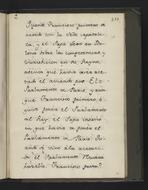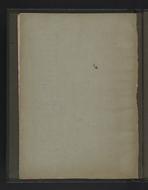Ms. Codex 1432 Decreto del rey don Phelipe Segundo para que ningun vasallo suyo se esté en la corte de Roma en tiempo de Paulo Quarto :
Title
Decreto del rey don Phelipe Segundo para que ningun vasallo suyo se esté en la corte de Roma en tiempo de Paulo Quarto :Authors
- Philip II, King of Spain, 1527-1598
- Cardenas y Zapata, Iñigo de
Other related names
- Lea, Henry Charles, 1825-1909, former owner
Call number
Ms. Codex 1432(Philadelphia, University of Pennsylvania, Rare Book & Manuscript Library)
Alternate identifiers
- bibid: 4454843
- http://hdl.library.upenn.edu/1017/d/medren/4454843
Publisher
The University of Pennsylvania LibrariesLanguage
SpanishOrigin
- Date
- 17--
- Place
-
Spain
Summary
Fragment from a larger manuscript containing two short texts. The first is a royal decree of King Philip II of Spain from 1557 banning all subjects of the Spanish crown from the Roman Curia during the reign of Pope Paul IV. The king gives no specific reason for the ban but does explain in detail that the decree is to be copied, distributed, and read aloud in the public areas of all cities, towns, and villages, and that the punishment for violating the ban may include confiscation of goods and property, exile, or execution. The second text is a short description of the relationship between the King of France and the parliament of Paris, as it relates to the working of the French government. It is written by the Spanish ambassador in France, Iñigo de Cardenas y Zapata, in 1621, apparently for the benefit of the Spanish government. To illustrate the nature of the French monarchy he cites two historical examples. The first is the secret agreement between Francis I, King of France, and Pope Leo X, arranged at Bologna in 1515, for which the Pope required the approval of the Paris parliament. The parliament initially refused and the King was forced to pressure them into consenting to the agreement, which illustrates the author's point that the parliament cannot be entirely bypassed by the King. The second example serves as a counterpoint and consists of Charles IX's efforts to be declared king before coming of age, with the support of his mother, Catherine de Médicis, and the dukes of France. The parliament of Paris refused to comply with his wishes and so he went instead to the parliament of Rohan, which recognized him as king of legal age, and thus enabled him to successfully bypass the parliament of Paris.
Notes
- Ms. codex.
- Title from title page (f. 1r).
Watermark
Similar to Valls i Subirá, Bas, 89, but the name inside the circle is unclear.Extent
14 leaves : 195 x 138 (175 x 95) mm. bound to 206 x 152 mmFoliation
Paper, i + 14 + ii; 300-313; [1-14]; contemporary foliation in ink, upper right recto; modern foliation in pencil, lower right recto.Support
PaperBinding
Modern boards (now detached).Layout
Script
Provenance
- Formerly owned by Henry Charles Lea (inscription, front flyleaf, 1888; bookplate, inside upper cover).
Subjects topical
- Catholic Church.--Curia Romana
- Church and state--Spain--Early works to 1800
Genres
- Codices
- Decrees
- Manuscripts, Spanish--18th century
- Manuscripts, European
Licenses
-
- Text
- This description is ©2015 University of Pennsylvania Libraries. It is licensed under a Creative Commons Attribution License version 4.0 (CC-BY-4.0 https://creativecommons.org/licenses/by/4.0/legalcode. For a description of the terms of use see the Creative Commons Deed https://creativecommons.org/licenses/by/4.0/.
- URL
- http://creativecommons.org/licenses/by/4.0/legalcode
-
- Text
- All referenced images and their content are free of known copyright restrictions and in the public domain. See the Creative Commons Public Domain Mark page for usage details, http://creativecommons.org/publicdomain/mark/1.0/.
- URL
- http://creativecommons.org/publicdomain/mark/1.0/
Images
 Inside front cover
Inside front cover0812_0001.tif (66.5 MB)
0812_0001_thumb.jpg (4.1 KB)
0812_0001_web.jpg (292.1 KB)






































